Abstract
Although not complete, the available sequence data on smooth muscle desmin, a prototype of 10 nm filaments present in living vertebrate cells, and two wool alpha-keratin components indicate a common structural motif . A similarly sized rod-like middle domain based mainly on alpha-helices probably able to form coiled-coils is flanked by differently sized terminal domains of non-alpha-helical nature. Within the middle domain there seem to be at least two regions where wool keratins and 10 nm filament proteins show a noticeable degree of sequence homology. In general, however, the proteins have diverged to an astonishing degree. Although the analysis seems to support, in general terms, a separation of the rod into two nearly equally long coiled-coils it raises doubts about additional aspects of current models of 10 nm filament organization. We propose that the terminal domains are directly involved in filament assembly making this process permanent in wool alpha-keratins because of the many disulfide bonds present in these regions. The 10 nm filaments of most living cells seem to avoid this frozen state and lack a similar wealth of cysteine residues.
Full text
PDF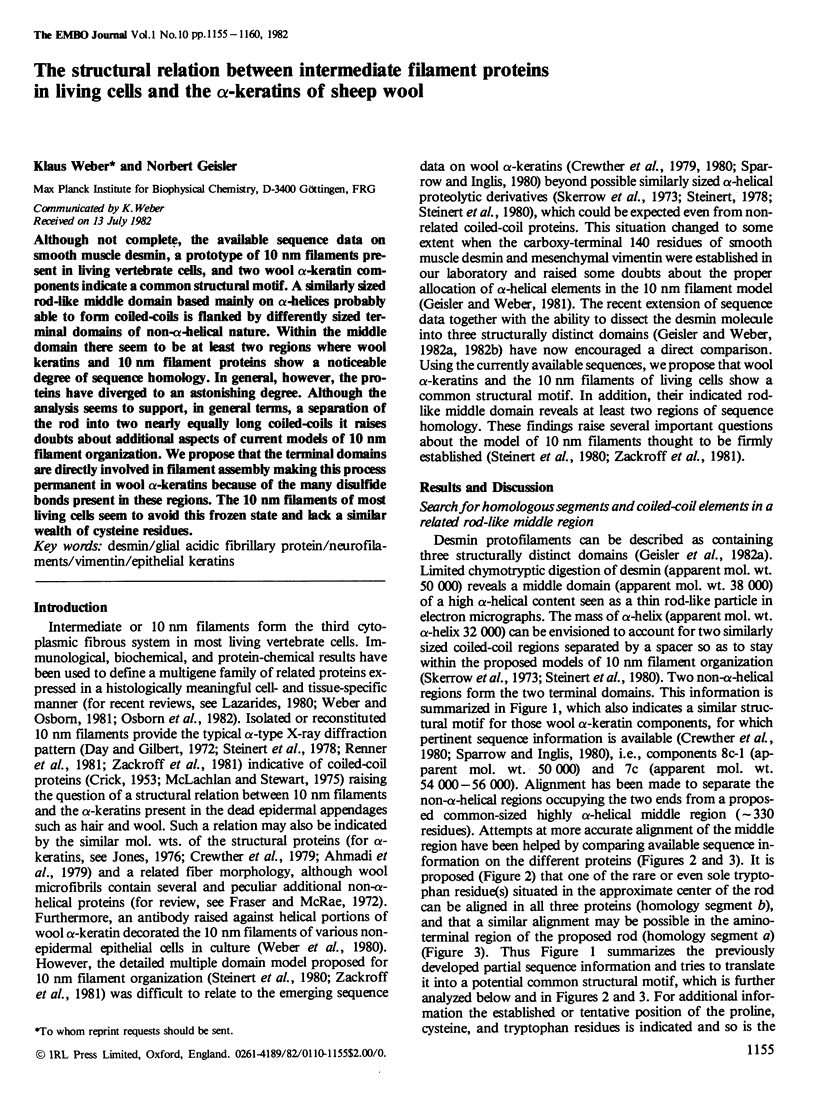
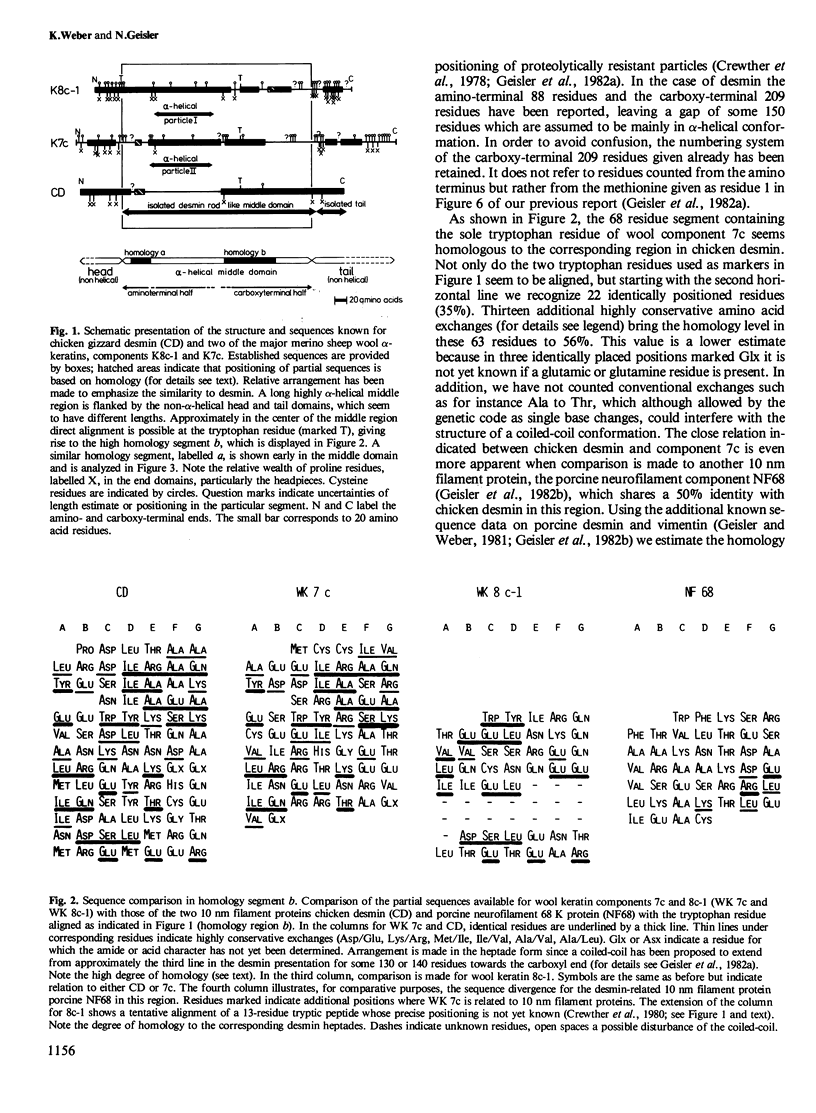
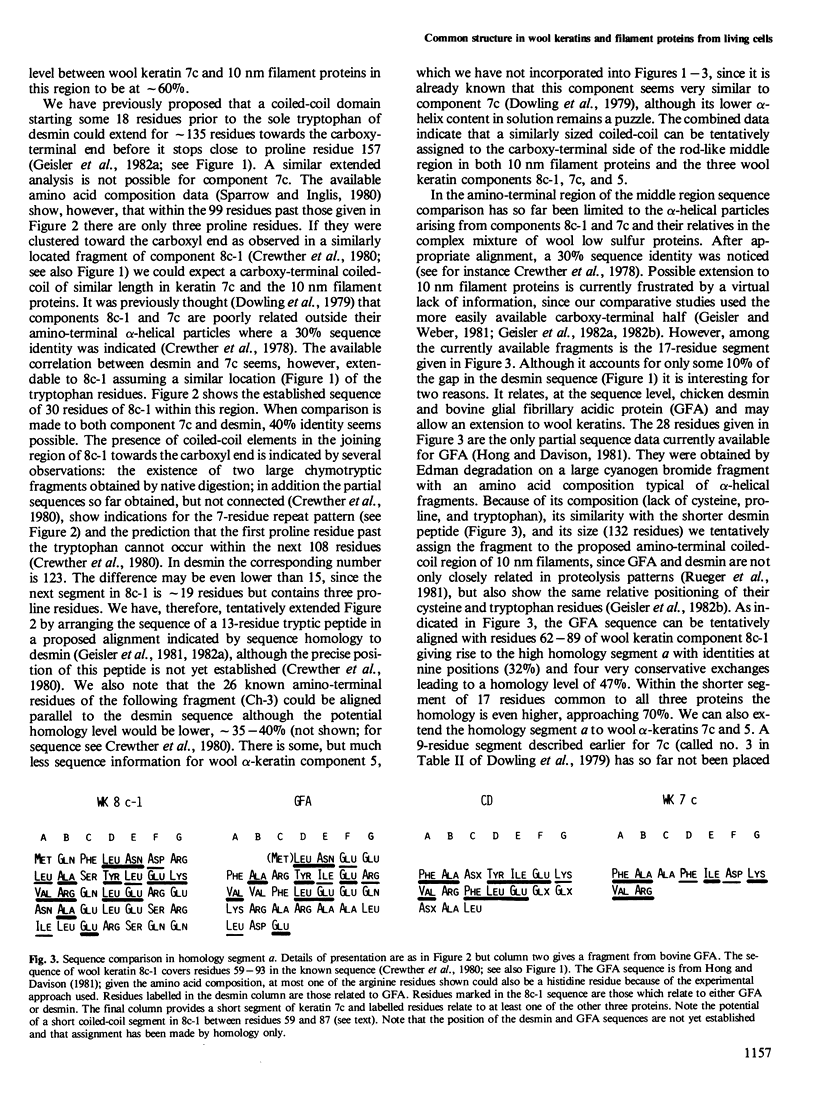
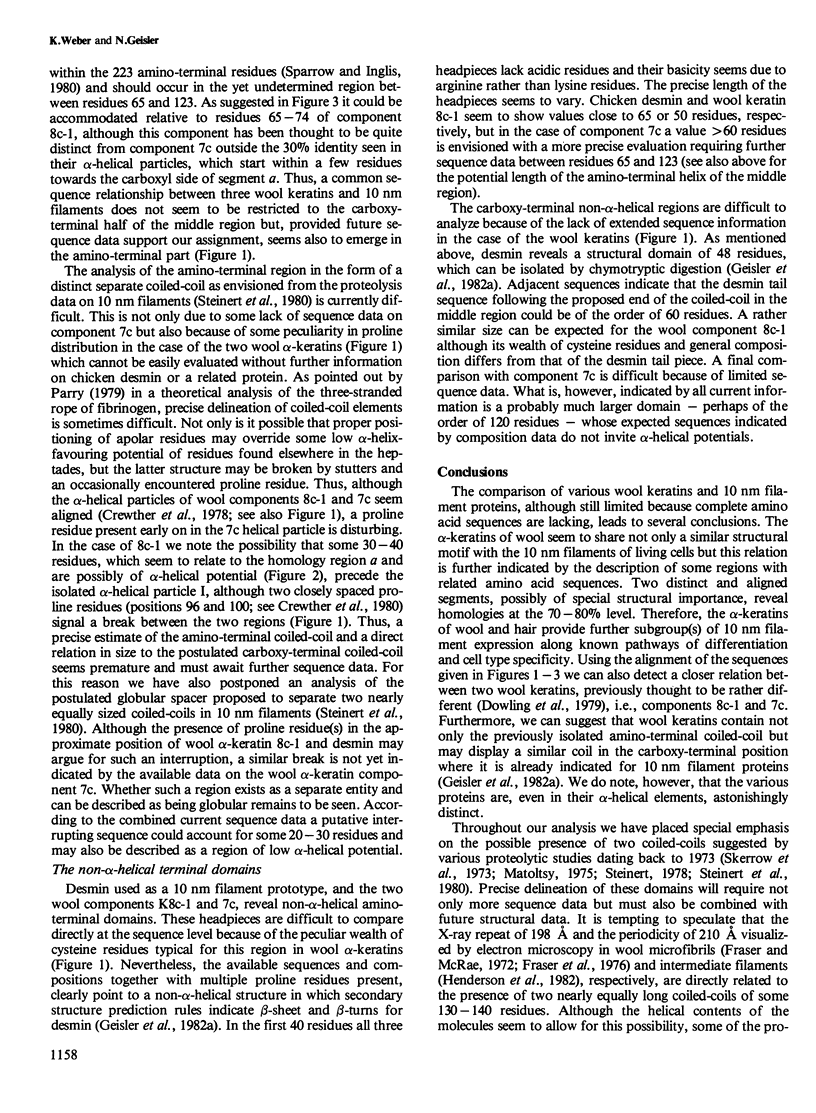
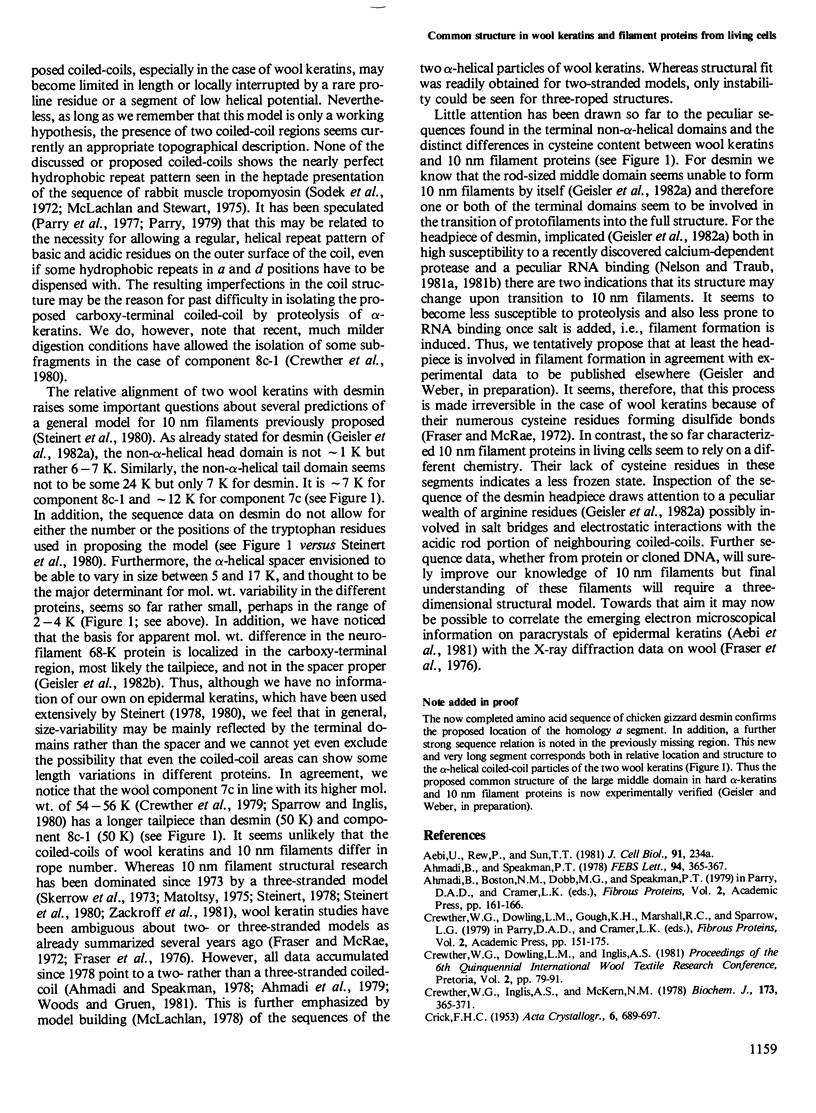
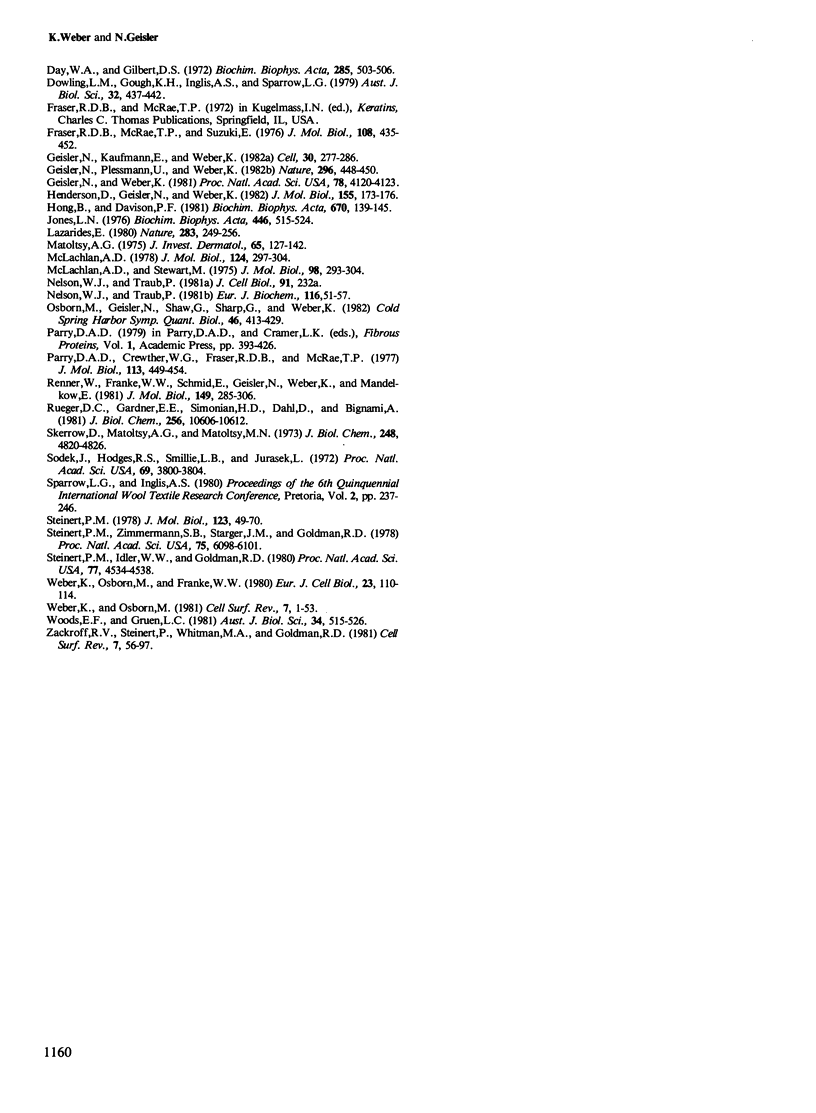
Selected References
These references are in PubMed. This may not be the complete list of references from this article.
- Ahmadi B., Speakman P. T. Suberimidate crosslinking shows that a rod-shaped, low cystine, high helix protein prepared by limited proteolysis of reduced wool has four protein chains. FEBS Lett. 1978 Oct 15;94(2):365–367. doi: 10.1016/0014-5793(78)80978-8. [DOI] [PubMed] [Google Scholar]
- Crewther W. G., Inglis A. S., McKern N. M. Amino acid sequences of alpha-helical segments from S-carboxymethylkerateine-A. Complete sequence of a type-II segment. Biochem J. 1978 Aug 1;173(2):365–371. doi: 10.1042/bj1730365. [DOI] [PMC free article] [PubMed] [Google Scholar]
- Day W. A., Gilbert D. S. X-ray diffraction pattern of axoplasm. Biochim Biophys Acta. 1972 Dec 28;285(2):503–506. doi: 10.1016/0005-2795(72)90342-x. [DOI] [PubMed] [Google Scholar]
- Fraser R. D., MacRae T. P., Suzuki E. Structure of the alpha-keratin microfibril. J Mol Biol. 1976 Dec;108(2):435–452. doi: 10.1016/s0022-2836(76)80129-5. [DOI] [PubMed] [Google Scholar]
- Geisler N., Kaufmann E., Weber K. Proteinchemical characterization of three structurally distinct domains along the protofilament unit of desmin 10 nm filaments. Cell. 1982 Aug;30(1):277–286. doi: 10.1016/0092-8674(82)90033-2. [DOI] [PubMed] [Google Scholar]
- Geisler N., Plessmann U., Weber K. Related amino acid sequences in neurofilaments and non-neural intermediate filaments. Nature. 1982 Apr 1;296(5856):448–450. doi: 10.1038/296448a0. [DOI] [PubMed] [Google Scholar]
- Geisler N., Weber K. Comparison of the proteins of two immunologically distinct intermediate-sized filaments by amino acid sequence analysis: desmin and vimentin. Proc Natl Acad Sci U S A. 1981 Jul;78(7):4120–4123. doi: 10.1073/pnas.78.7.4120. [DOI] [PMC free article] [PubMed] [Google Scholar]
- Henderson D., Geisler N., Weber K. A periodic ultrastructure in intermediate filaments. J Mol Biol. 1982 Feb 25;155(2):173–176. doi: 10.1016/0022-2836(82)90444-2. [DOI] [PubMed] [Google Scholar]
- Hong B. S., Davison P. F. Isolation and characterization of a soluble, immunoactive peptide of glial fibrillary acidic protein. Biochim Biophys Acta. 1981 Sep 29;670(2):139–145. doi: 10.1016/0005-2795(81)90001-5. [DOI] [PubMed] [Google Scholar]
- Jones L. N. Studies on microfibrils from alpha-keratin. Biochim Biophys Acta. 1976 Oct 28;446(2):515–524. doi: 10.1016/0005-2795(76)90018-0. [DOI] [PubMed] [Google Scholar]
- Lazarides E. Intermediate filaments as mechanical integrators of cellular space. Nature. 1980 Jan 17;283(5744):249–256. doi: 10.1038/283249a0. [DOI] [PubMed] [Google Scholar]
- Matoltsy A. G. Desmosomes, filaments, and keratohyaline granules: their role in the stabilization and keratinization of the epidermis. J Invest Dermatol. 1975 Jul;65(1):127–142. doi: 10.1111/1523-1747.ep12598093. [DOI] [PubMed] [Google Scholar]
- McLachlan A. D. Coiled coil formation and sequence regularities in the helical regions of alpha-keratin. J Mol Biol. 1978 Sep 5;124(1):297–304. doi: 10.1016/0022-2836(78)90163-8. [DOI] [PubMed] [Google Scholar]
- McLachlan A. D., Stewart M. Tropomyosin coiled-coil interactions: evidence for an unstaggered structure. J Mol Biol. 1975 Oct 25;98(2):293–304. doi: 10.1016/s0022-2836(75)80119-7. [DOI] [PubMed] [Google Scholar]
- Nelson W. J., Traub P. Properties of Ca2+-activated protease specific for the intermediate-sized filament protein vimentin in Ehrlich-ascites-tumour cells. Eur J Biochem. 1981 May;116(1):51–57. doi: 10.1111/j.1432-1033.1981.tb05299.x. [DOI] [PubMed] [Google Scholar]
- Osborn M., Geisler N., Shaw G., Sharp G., Weber K. Intermediate filaments. Cold Spring Harb Symp Quant Biol. 1982;46(Pt 1):413–429. doi: 10.1101/sqb.1982.046.01.040. [DOI] [PubMed] [Google Scholar]
- Parry D. A., Crewther W. G., Fraser R. D., MacRae T. P. Structure of alpha-keratin: structural implication of the amino acid sequences of the type I and type II chain segments. J Mol Biol. 1977 Jun 25;113(2):449–454. doi: 10.1016/0022-2836(77)90153-x. [DOI] [PubMed] [Google Scholar]
- Renner W., Franke W. W., Schmid E., Geisler N., Weber K., Mandelkow E. Reconstitution of intermediate-sized filaments from denatured monomeric vimentin. J Mol Biol. 1981 Jun 25;149(2):285–306. doi: 10.1016/0022-2836(81)90303-x. [DOI] [PubMed] [Google Scholar]
- Rueger D. C., Gardner E. E., Der Simonian H., Dahl D., Bignami A. Purified glial fibrillary acidic protein and desmin are distinct intermediate filament proteins exhibiting similar properties. J Biol Chem. 1981 Oct 25;256(20):10606–10612. [PubMed] [Google Scholar]
- Skerrow D., Matoltsy A. G., Matoltsy M. N. Isolation and characterization of the helical regions of epidermal prekeratin. J Biol Chem. 1973 Jul 10;248(13):4820–4826. [PubMed] [Google Scholar]
- Sodek J., Hodges R. S., Smillie L. B., Jurasek L. Amino-acid sequence of rabbit skeletal tropomyosin and its coiled-coil structure. Proc Natl Acad Sci U S A. 1972 Dec;69(12):3800–3804. doi: 10.1073/pnas.69.12.3800. [DOI] [PMC free article] [PubMed] [Google Scholar]
- Steinert P. M., Idler W. W., Goldman R. D. Intermediate filaments of baby hamster kidney (BHK-21) cells and bovine epidermal keratinocytes have similar ultrastructures and subunit domain structures. Proc Natl Acad Sci U S A. 1980 Aug;77(8):4534–4538. doi: 10.1073/pnas.77.8.4534. [DOI] [PMC free article] [PubMed] [Google Scholar]
- Steinert P. M. Structure of the three-chain unit of the bovine epidermal keratin filament. J Mol Biol. 1978 Jul 25;123(1):49–70. doi: 10.1016/0022-2836(78)90376-5. [DOI] [PubMed] [Google Scholar]
- Steinert P. M., Zimmerman S. B., Starger J. M., Goldman R. D. Ten-nanometer filaments of hamster BHK-21 cells and epidermal keratin filaments have similar structures. Proc Natl Acad Sci U S A. 1978 Dec;75(12):6098–6101. doi: 10.1073/pnas.75.12.6098. [DOI] [PMC free article] [PubMed] [Google Scholar]
- Weber K., Osborn M., Franke W. W. Antibodies against merokeratin from sheep wool decorate cytokeratin filaments in non-keratinizing epithelial cells. Eur J Cell Biol. 1980 Dec;23(1):110–114. [PubMed] [Google Scholar]
- Woods E. F., Gruen L. C. Structural studies on the microfibrillar proteins of wool: characterization of the alpha-helix-rich particle produced by chymotryptic digestion. Aust J Biol Sci. 1981;34(5-6):515–526. doi: 10.1071/bi9810515. [DOI] [PubMed] [Google Scholar]


